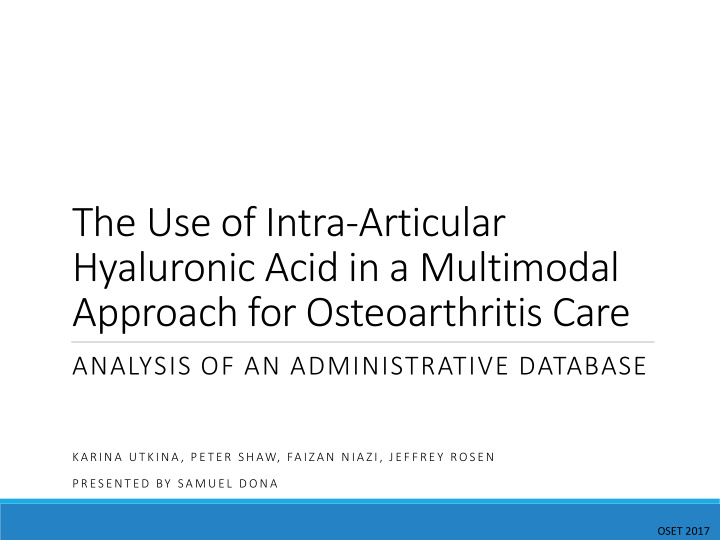



The Use of Intra-Articular Hyaluronic Acid in a Multimodal Approach for Osteoarthritis Care ANALYSIS OF AN ADMINISTRATIVE DATABASE K A R I N A U T K I N A , P E T E R S H AW, FA I ZA N N I A Z I , J E F F R E Y RO S E N P R ES E N T E D BY SA M U E L D O N A OSET 2017
Disclos osures es • Samuel Dona, MD : No Financial Disclosures. Sports Medicine Fellow, Atlantic Sports Health • Karina Utkina, Peter Shaw, and Faizan Niazi are employed by Ferring Pharmaceuticals • Jeffrey Rosen: Advisory board member for Ferring Pharmaceuticals and Flexion Therapeutics. Department of Orthopaedics & Rehabilitation, New York Presbyterian Queens; Weill Medical College of Cornell University Research Funded by: Ferring Pharmaceuticals •
Background • Knee osteoarthritis (OA) is a progressive and degenerative disease that often leads to the need for a total knee replacement (TKR) as the severity of the disease progresses. • Many non-surgical treatment options are available for the management of knee OA prior to the need for TKR, including (but not limited to): • Bracing • Corticosteroids (CS) • Intra-articular hyaluronic acid (IA-HA) injections • Current research typically aims to identify the superiority of these available treatment options, yet a multimodal approach is often what is prescribed and utilized by real-world patients with knee OA. Study Objective
Methods Study Design • Retrospective facility, professional, and pharmacological claims analysis of the Blue Cross/ Blue Shield (BCBS) database from October 1st, 2010 - September 30th, 2015. Outcomes • Time from the first OA treatment code within the database to the time of TKR. Data Analysis • Kaplan-Meier survival analysis to determine the TKR-free survival of patients who received: • IA-HA injections alone • IA-HA and bracing • IA-HA and CS injection • IA-HA and both CS and bracing • Most patients were assumed to have typically taken simple analgesics during their OA treatment regimen.
Results • 181,631 patients were included in the analysis: BHI Database 181,631 IA-HA alone IA-HA + Brace IA-HA + CS IA-HA + Brace + CS 58,429 5,276 106,412 11,504
Results • There is an apparent delay to TKR over a 3 year follow-up period, after which time the cohorts converge beyond 3 years. • Patients treated with HA alone had a lower cumulative TKA-free rate compared to multimodal cohorts. • Patients treated with a combination of HA with either CS OR bracing demonstrated similar results. The greatest benefit for TKR-free • survival in HA + CS + Bracing patient cohort.
Results HA Alone HA + Brace HA+CS HA + Brace + CS 12 months N at Risk 26321 2852 69464 8782 N TKRs 7947 524 10977 910 % TKR-Free 80.30% 86.40% 87.60% 91.20% 24 months N at Risk 14018 1581 40666 5558 N TKRs 11876 914 21432 2059 % TKR-Free 65.80% 72.20% 72.20% 77.50% 36 months N at Risk 6775 769 21428 3059 N TKRs 13860 1140 27558 2905 % TKR-Free 54.00% 58.90% 59.00% 63.30% 48 months N at Risk 2412 262 8235 1195 N TKRs 14810 1242 30951 3418 % TKR-Free 43.30% 47.50% 46.40% 49.10%
Results This study is limited by the lack of clinical outcome measures and patient disease status due to the use of an administrative database. Analysis is limited to what has been previously collected, and the authorship team is unable to consider all relevant variables if they were not captured. This study is strengthened by the large sample size and comprehensive analysis of a very large administrative database. These results indicate that the use of multimodal treatment regimens may provide greater benefit in delaying the need for TKR within patients with knee OA.
Conclusions 1 • IA-HA provides distinct clinical benefit within a multimodal approach to treatment of knee OA. 2 • The greatest benefit was seen within the patients who had received all three evaluated treatment options, followed by the groups who had received combined therapy of two interventions, and finally the group who had received IA-HA alone. IA-HA + IA-HA + Bracing / IA- IA-HA Bracing + CS HA + CS 3 • Future research should consider the use of multimodal therapy for the management of knee OA instead of focusing on comparisons between individual treatment options.
Recommend
More recommend